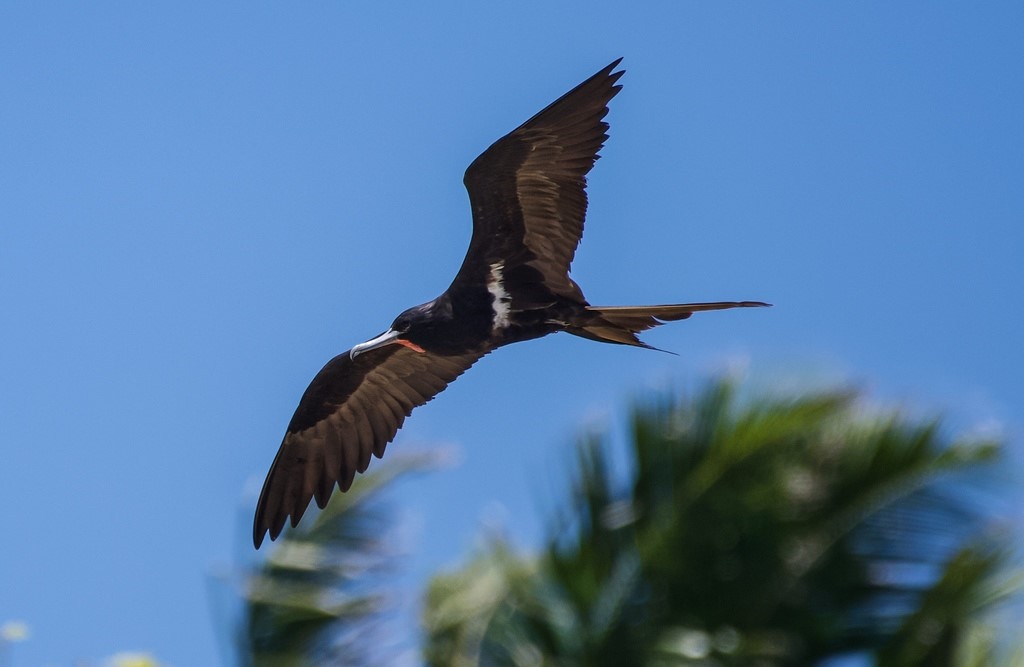Birdfinding.info ⇒ The predominant frigatebird across much of the Indo-Pacific region, especially from Indonesia to western Polynesia. Areas where it is regularly seen in large numbers include Jakarta Bay (Java), the Phi Phi Islands (east of Phuket, Thailand), Port Moresby (New Guinea), Darwin (Northern Australia), Fiji, and Tahiti. Smaller numbers are regularly found along the coasts of Taiwan (mainly May to September) and locally along the eastern coast of Australia, including Cairns, Townsville, and several of the islands offshore from Gladstone (especially Lady Elliot Island).
Lesser Frigatebird
Fregata ariel
Pantropical, from the South Atlantic to the central Pacific Ocean.
Breeding. Mainly on remote tropical islands nearly throughout the Indian and South Pacific Oceans, including: Europa; the Seychelles; the Maldives; the Chagos Archipelago; the Cocos (Keeling) Islands; Christmas Island; various islets in the Timor, Banda, and Arafura Seas; the Bismarck Archipelago; the Solomon Islands; Fiji; Tonga; the Cook Islands; and east across most of Polynesia to the Tuamotu Archipelago.
In the South Atlantic, the “Trindade Frigatebird” (F. a. trinitatis) breeds on Trindade (and possibly also on Martin Vaz, although this is speculative). This form is critically endangered and appeared to be on the verge of extirpation in the 2010s.
Dedicated surveys of Trindade in February to April 2013 yielded observations of at least six individuals, including two males, two females, and two juveniles in the suspected nesting area at the south end of the island. The other historical nesting area, at Martin Vaz, is more remote and apparently has not been surveyed in recent years.

Two female “Trindade Frigatebirds,” F. a. trinitatis, on Ilha da Trindade in 2013. © Port et al. 2016
Nonbreeding. Wanders year-round throughout the tropical Indian and Pacific Oceans from eastern South Africa to Hawaii and the Tuamotu Archipelago.
During much of the year, significant numbers occur along the Malay Peninsula, in the Philippines, throughout much of Indonesia, and around New Guinea and the tropical coasts of Australia. Smaller numbers disperse to the coasts of eastern Africa and southwestern India.
In Hawaii, wanderers appear most years in the Northwest Chain and occasionally remain long-term (with at least one nest recorded on French Frigate Shoals), and there are at least six records from the main islands.
From May to November, small numbers regularly appear along coasts of the western Pacific, including southern and central China, Taiwan, and southern Japan; occasionally to Hokkaido, the Sea of Okhotsk, and inland in northeastern China.
Accidental in North America, with isolated records from California, Wyoming, Michigan, and Maine—three in July and the other in September. Records of unidentified frigatebirds observed in Alaska may be more likely Lesser than Magnificent, considering Lesser’s pattern of dispersal to eastern Russia.
Identification
The smallest frigatebird, but larger than most other seabirds: its full length is about 75 cm and its wingspan approaches two meters.
It is distinctive in that all plumages share a feature that is mostly absent from other frigatebirds: white streaks in the “armpits,” which are especially noticeable on the adult male.
Acquires its definitive adult plumage over the course of several years, resulting in six more or less distinct plumages: juvenile, older immature, and the subadult and adult plumages of each sex.
The “Trindade Frigatebird” (F. a. trinitatis) closely resembles the Indian and Pacific Ocean subspecies, at least in their adult plumages. There is some doubt and controversy as to whether any of its immature plumages differ consistently.

Lesser Frigatebird, male showing distinctive combination of black plumage with white armpits. (Tamulol, Papua Barat, Papua, Indonesia; February 4, 2017.) © Bruce Purdy
Adult Male. Adult male has all-blackish plumage with the exception of white streaks in its “armpits,” which are distinctive (although males of some other species sometimes show a much fainter version of this marking).
Like all male frigatebirds, it has a bright-red throat-pouch, which it inflates like a balloon during mating and dominance displays, but can be inconspicuous when deflated.
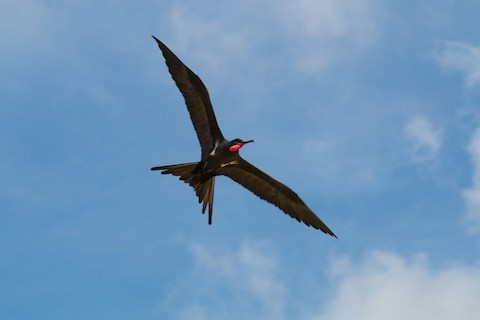
Lesser Frigatebird, male with throat-pouch partly inflated. (Christmas Island; July 9, 2017.) © Hickson Fergusson
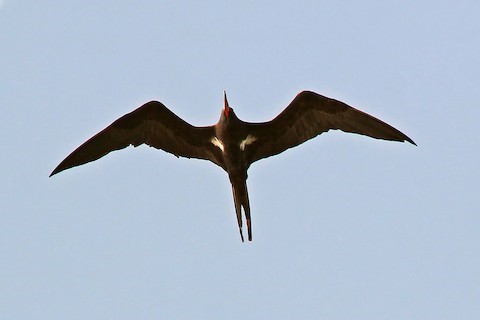
Lesser Frigatebird, male. (Halmahera, Indonesia; September 13, 2014.) © Phillip Edwards
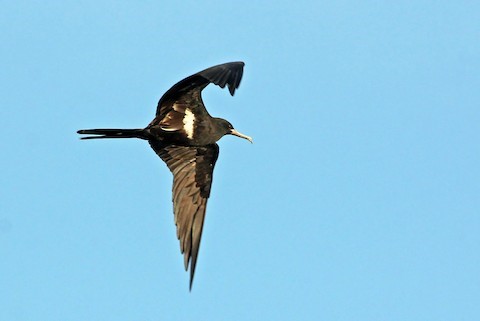
Lesser Frigatebird, male showing conspicuous white armpit patches. (Buru, Indonesia; September 23, 2014.) © Phillip Edwards

Lesser Frigatebird, male with comparatively inconspicuous white armpit patches. (Michaelmas Cay, Queensland, Australia; September 6, 2015.) © Margot Oorebeek
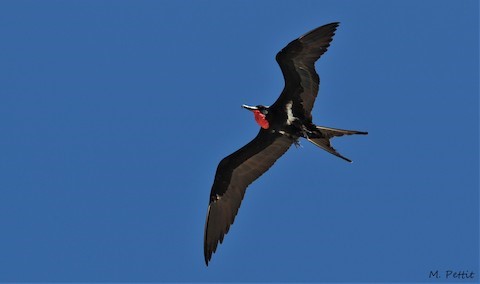
Lesser Frigatebird, male with throat-pouch partly inflated. (East Island, Ashmore Reef, Western Australia; April 29, 2019.) © Magen Pettit

Lesser Frigatebird, male showing conspicuous white armpit patches. (Hood Lagoon, Papua New Guinea; August 4, 2018.) © Chris Barnes
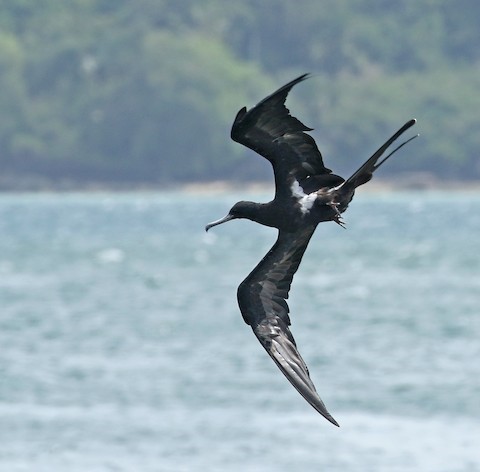
Magnificent Frigatebird, male chasing a falling fish—note purplish gloss on back. (Brickfield, Trinidad; January 4, 2017.) © Tom Johnson
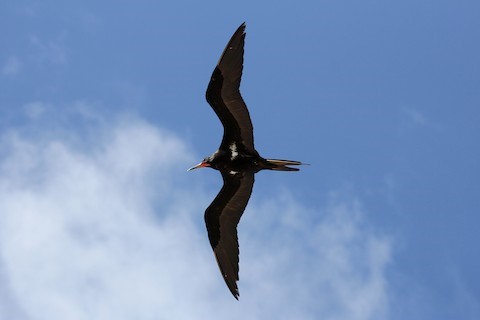
Lesser Frigatebird, male. (Michaelmas Cay, Queensland, Australia; September 6, 2015.) © Ray Turnbull
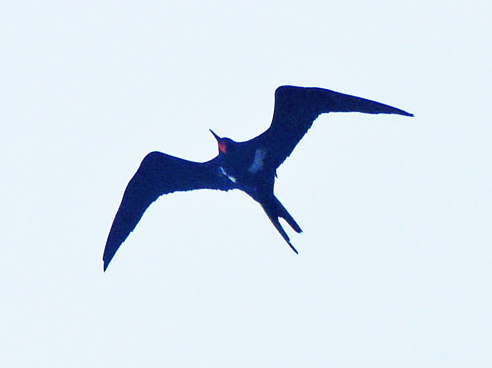
“Trindade Frigatebird,” F. a. trinitatis, male. (Ilha da Trindade, Brazil; December 7, 2017.) © Daniela Maia
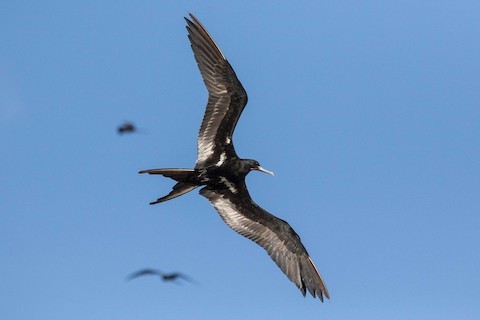
Lesser Frigatebird, male. (Cassidy Airport, Christmas Island, Line Islands, Kiribati; August 20, 2019.) © Eric VanderWerf
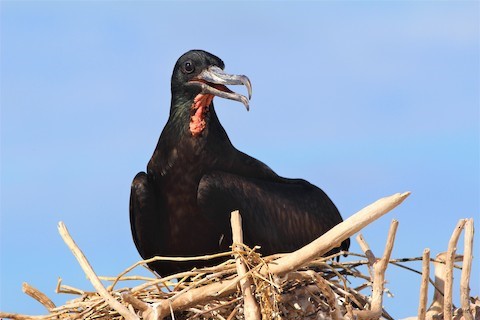
Lesser Frigatebird, male. (Middle Island, Ashmore Reef, Western Australia; April 29, 2019.) © Magen Pettit
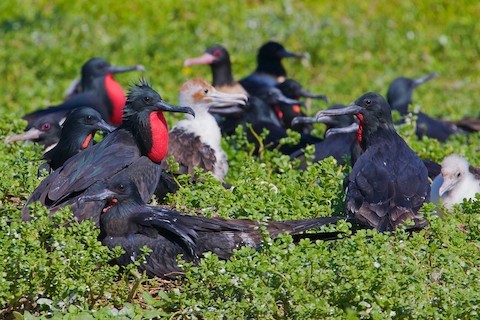
Lesser Frigatebird, breeding colony scene with at least two females, two juveniles, and several males, two of which show partly inflated throat-pouches. (Naevo Island, Fiji; July 16, 2011.) © Michael Andersen
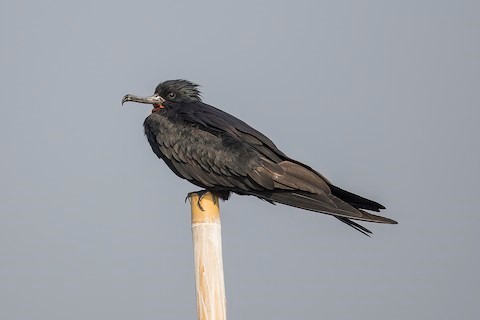
Lesser Frigatebird, male, appearing all-black when perched. (Jakarta Bay, Java, Indonesia; August 5, 2018.) © Matthew Kwan
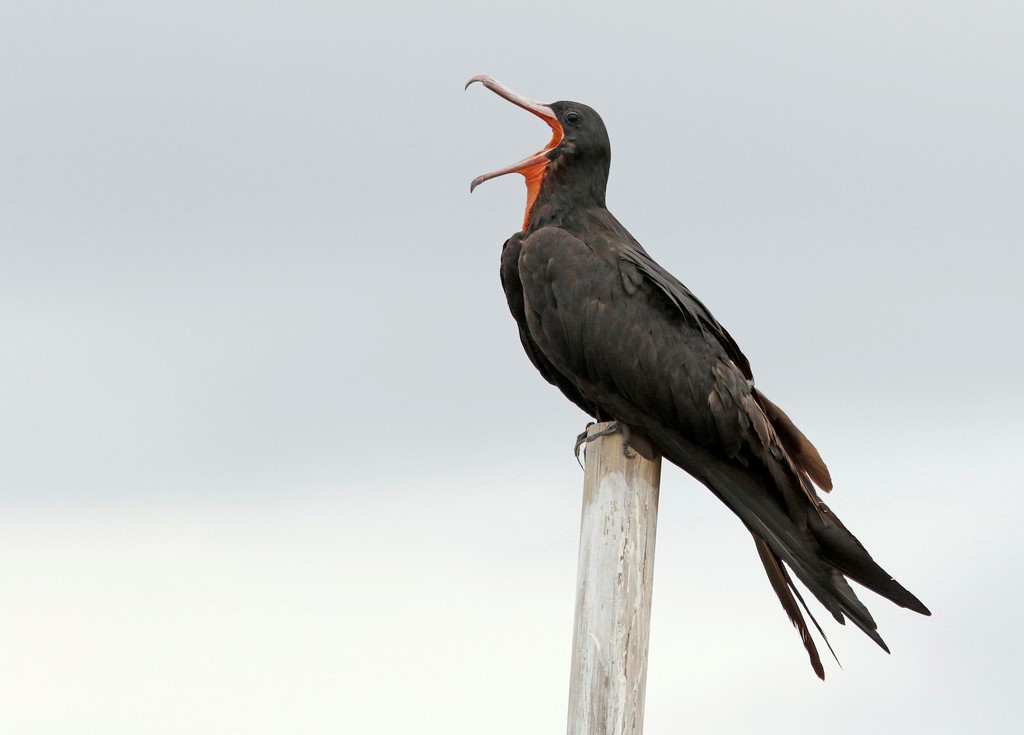
Lesser Frigatebird, male. (Jakarta Bay, Java, Indonesia; March 5, 2018.) © David Beadle
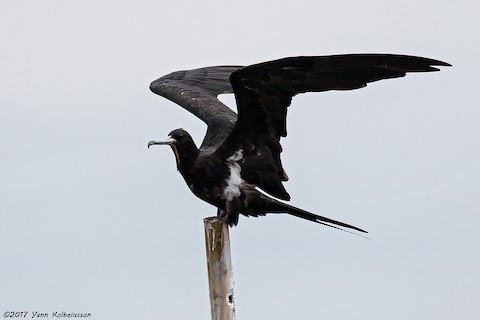
Lesser Frigatebird, male. (Jakarta Bay, Java, Indonesia; November 23, 2017.) © Yann Kolbeinsson
Adult Female. Adult female is mostly blackish with a large white vest and a distinct hood (unlike female Great).
The shape of the white vest can be helpful in identification. First, it is somewhat U-shaped, as the black belly area extends forward centrally and the white sides extend farther back. Second, white triangular projections extend into the “armpits.”
The bill and eyering are often pink, but can also be bluish-gray.
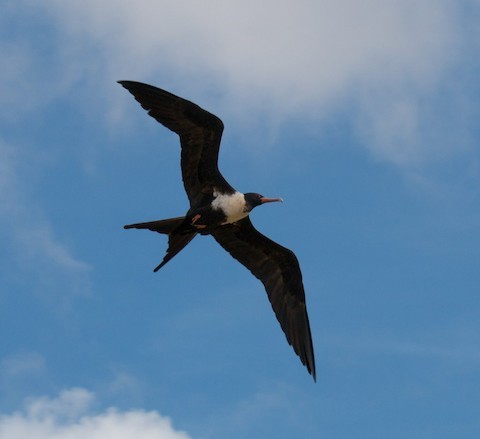
Lesser Frigatebird, female with pink bill and eyering. (Christmas Island; July 9, 2017.) © Hickson Fergusson
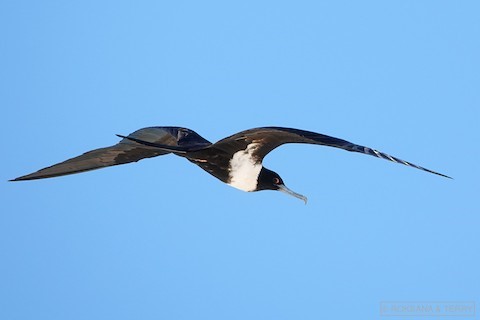
Lesser Frigatebird, female. (Michaelmas Cay, Queensland, Australia; August 12, 2018.) © Roksana and Terry

Lesser Frigatebird, female with pink bill and eyering. (Michaelmas Cay, Queensland, Australia; August 16, 2018.) © Roksana and Terry
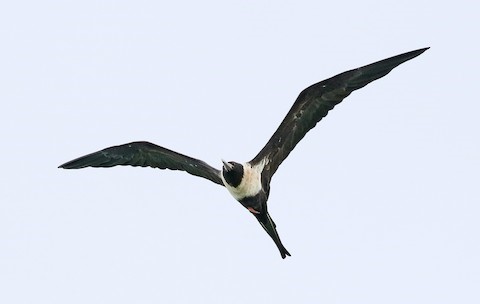
Lesser Frigatebird, female with bluish-gray bill and eyering. (Pulau Mantanani Besar, Sabah, Malaysia; November 5, 2018.) © Dave Bakewell
Although the upperparts are mostly blackish-brown, each wing has a blond “alar” bar that extends from the wrist back along the coverts toward the rump.

Lesser Frigatebird, female with bluish-gray bill and eyering—note broad white collar and pale alar bar on upperwing. (Cendrawasih, Nabire, Papua, Indonesia; July 30, 2016.) © Chien C. Lee

Lesser Frigatebird, female with pink bill and eyering. (Middle Island, Ashmore Reef, Western Australia; April 29, 2019.) © Magen Pettit

Lesser Frigatebird, female with pink bill and eyering. (Jalan Raya Karang Serang, Banten, Java, Indonesia; August 5, 2018.) © Matthew Kwan
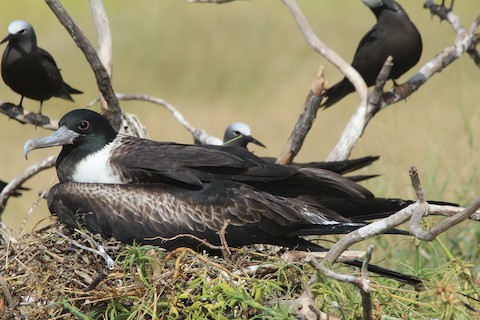
Lesser Frigatebird, female with bluish-gray bill and eyering. (West Island, Ashmore Reef, Western Australia; April 29, 2019.) © Magen Pettit
Juveniles and Older Immatures. Young Lesser Frigatebirds are highly variable, especially in the coloration of the head, neck, and chest.
Juvenile is brown overall, with mostly white underparts and a tawny head, neck, and chest. The tawny color varies in intensity from pale-buff to orange or reddish (resembling juvenile Great and Christmas Frigatebirds).
The juvenal plumage has a heavy dark collar on the neck and chest—sometimes partial, sometimes complete and broad—on some individuals, only the lower breast or mid-belly appears white (a triangular patch when viewed from below). The dark collar tends to disappear during the first year, lightening the underparts.
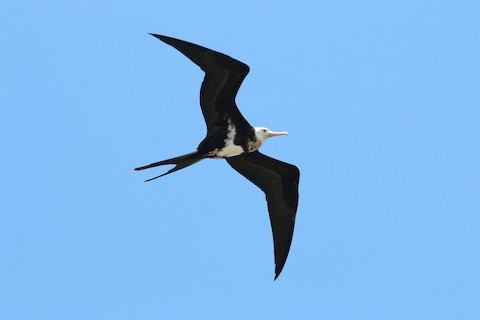
Lesser Frigatebird, juvenile. (Tai Lake, Kinmen County, Taiwan; August 2, 2018.) © Han-Bo Chang
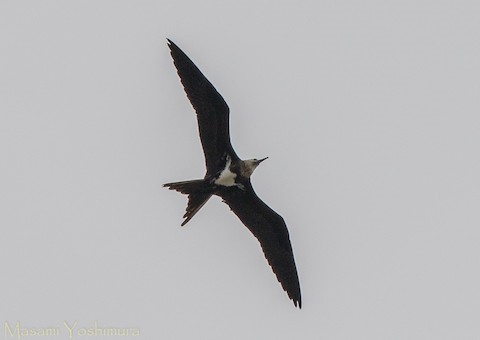
Lesser Frigatebird, juvenile, showing triangular white patch from lower breast to mid-belly. (Matsusaka, Mie, Honshu, Japan; September 3, 2016.) © Masami Yoshimura

Lesser Frigatebird, juvenile, showing triangular white patch from lower breast to mid-belly. (Richards Bay, Kwazulu-Natal, South Africa; January 15, 2018.) © Niall D. Perrins
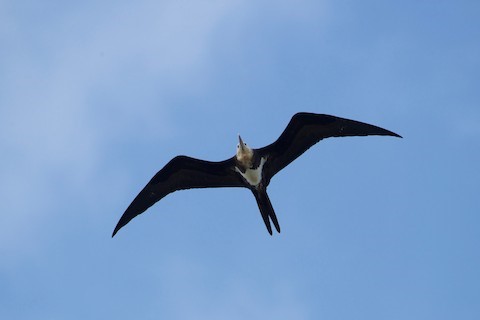
Lesser Frigatebird, juvenile, showing triangular white patch from lower breast to mid-belly. (Nanhui Dongtan, Shanghai, China; August 2, 2018.) © Yasuhiko Kumatsu
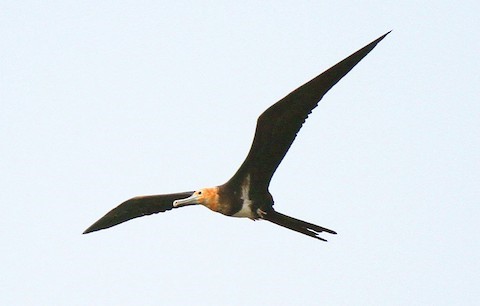
Lesser Frigatebird, juvenile. (Miyun Reservoir, Beijing, China; August 21, 2014.) © PT Xiao
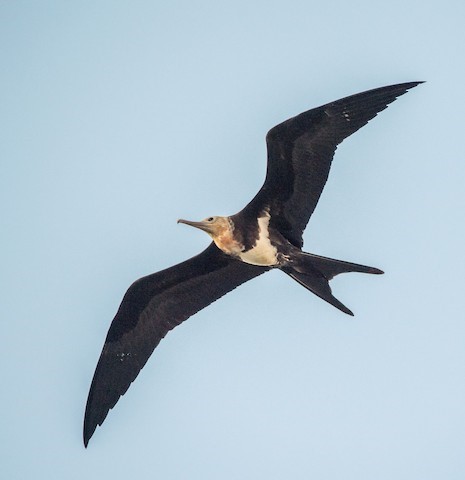
Lesser Frigatebird, juvenile. (Nanhui Dongtan, Shanghai, China; August 2, 2018.) © Kai Pflug
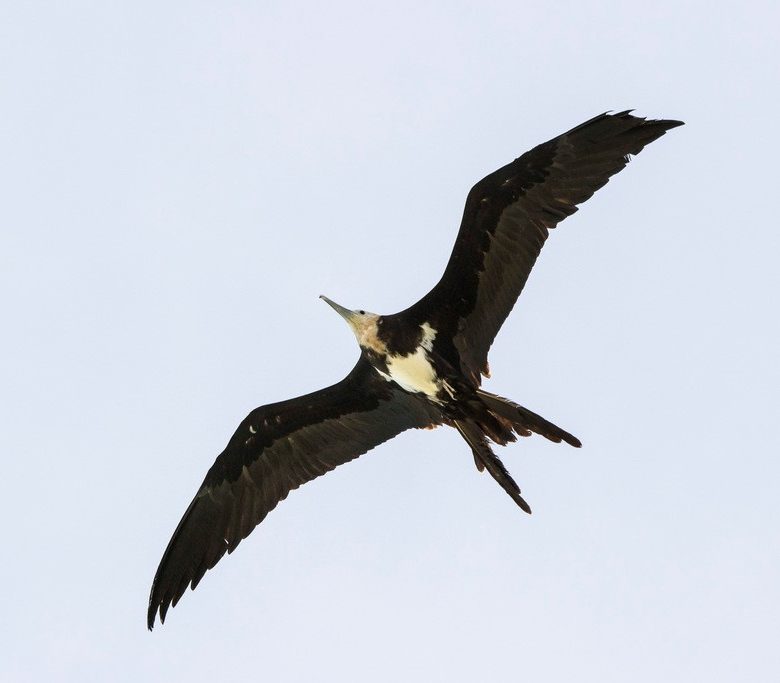
Lesser Frigatebird, juvenile with apparently broken primaries, showing triangular white patch from lower breast to mid-belly. (Muriwai, North Island, New Zealand; April 3, 2018.) © Oscar Thomas

Lesser Frigatebird, juvenile. (Kudat Fish Market, Sabah, Malaysia; October 26, 2019.) © Dave Bakewell
Like the adult female, the immature plumages have a pale alar bar on the upperwings, and as in all Lesser plumages, white projections extend into the armpits.

Lesser Frigatebird, juvenile, showing pale alar bars on upperwings. (Taipei, Taiwan; June 7, 2018.) © Poshien Chien

Lesser Frigatebird, juvenile, showing pale alar bars on upperwings. (Taipei, Taiwan; June 7, 2018.) © Poshien Chien

Lesser Frigatebird, juvenile showing pale alar bars on upperwings. (Jimbaran, Bali, Indonesia; August 20, 2016.) © Steve Jones
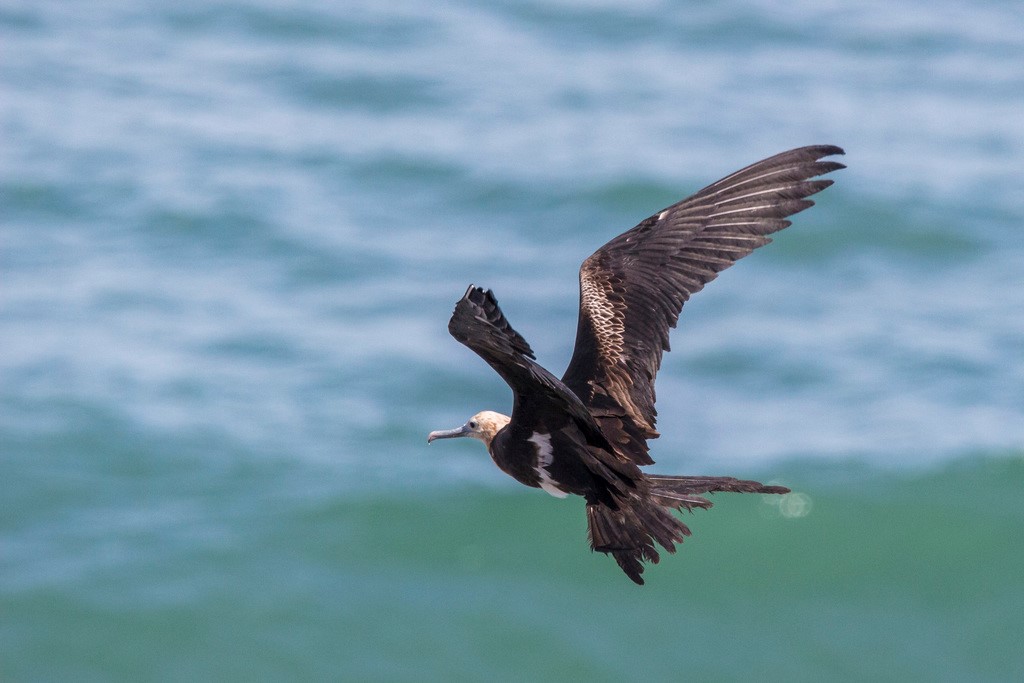
Lesser Frigatebird, juvenile showing white armpit marking and pale alar bar on upperwing. (Muriwai, North Island, New Zealand; April 3, 2018.) © Oscar Thomas

Lesser Frigatebird, juvenile, showing mostly dark underparts and pale alar bar on upperwing. (Wujie, Yilan County, Taiwan; July 30, 2017.) © Ko Cheng

Lesser Frigatebird, juvenile, showing pale alar bar on upperwing. (Wujie, Yilan County, Taiwan; July 30, 2017.) © Ko Cheng
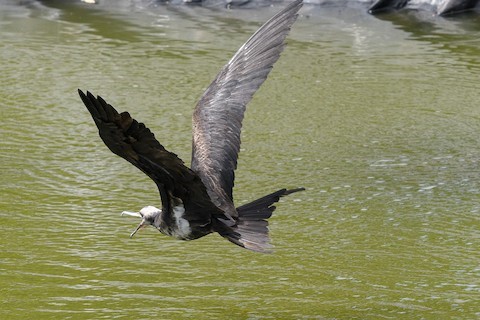
Lesser Frigatebird, older immature showing irregular progression of white and black. (Phosphate Hill, Christmas Island; September 1, 2019.) © Richard Smart
First-cycle immatures have almost entirely white underparts, but often with a partial collar. The head can be either white or buffy.
Second-cycle birds develop some darker patches mainly around the head and belly, then differentiate into the sex-specific subadult plumages.
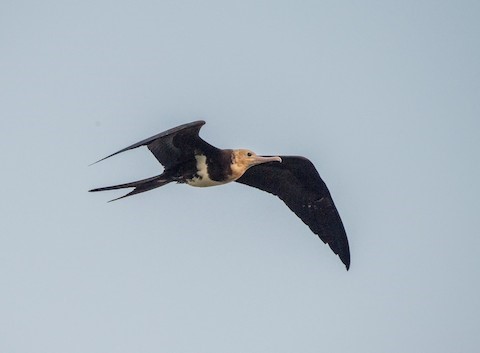
Lesser Frigatebird, juvenile (above) with older immature—note difference in the extent of dark coloration on underparts. (Halmahera, Indonesia; September 13, 2014.) © Phillip Edwards
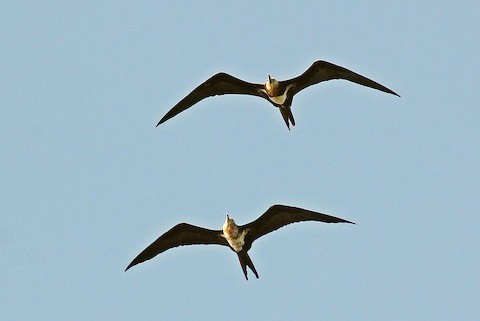
Lesser Frigatebird, juvenile (above) with older immature—note difference in the extent of dark coloration on underparts. (Halmahera, Indonesia; September 13, 2014.) © Phillip Edwards

Lesser Frigatebird, older immature showing irregular progression of white and black on underparts. (Michaelmas Cay, Queensland, Australia; September 6, 2015.) © Ray Turnbull
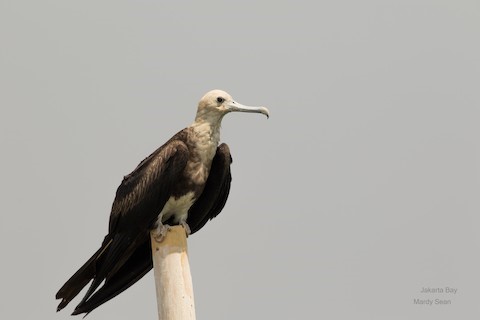
Lesser Frigatebird, immature with mostly pale head and underparts. (Jakarta Bay, Java, Indonesia; August 22, 2019.) © Mardy Sean
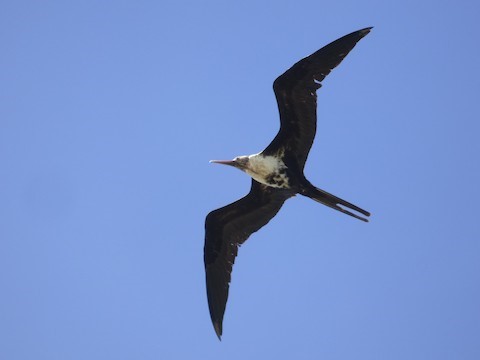
Lesser Frigatebird, older immature with white chest and darkening belly. (Nanhui Dongtan, Shanghai, China; August 18, 2018.) © Daniel Shi
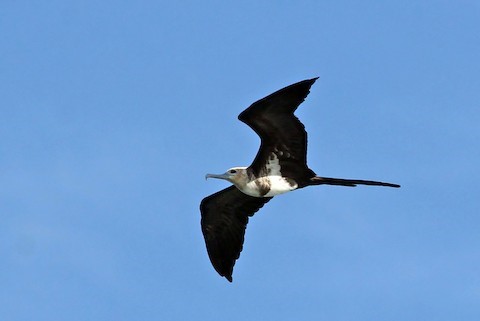
Lesser Frigatebird, immature—paler underparts than in juvenal plumage. (Buru, Indonesia; September 23, 2014.) © Phillip Edwards

Lesser Frigatebird, juvenile showing mostly dark underparts with white armpit marking and pale alar bar on upperwing. (Jakarta Bay, Java, Indonesia; August 5, 2018.) © Matthew Kwan
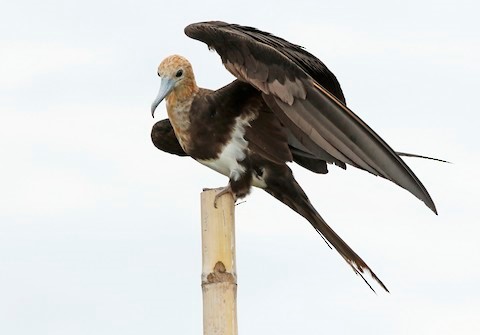
Lesser Frigatebird, juvenile. (Jakarta Bay, Java, Indonesia; March 5, 2018.) © David Beadle
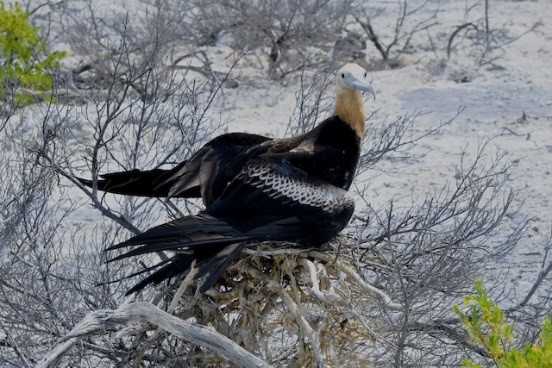
Lesser Frigatebird, juvenile showing pale head, rusty neck, and pale alar bar. (Ngaontetaae Island, Kiribati; November 5, 2016.) © John Doty

Lesser Frigatebird, juveniles with vividly rusty heads. (Naevo Island, Fiji; July 16, 2011.) © Michael Andersen

Lesser Frigatebird, juvenile showing rusty head and pale alar bar. (Jakarta Bay, Java, Indonesia; March 5, 2018.) © David Beadle

Lesser Frigatebird, juvenile showing complete black breastband. (Ngaontetaae Island, Kiribati; November 5, 2016.) © John Doty
Subadult Female. Subadult females go through intermediate stages in which the white on the head and belly fills in with darker feathers.
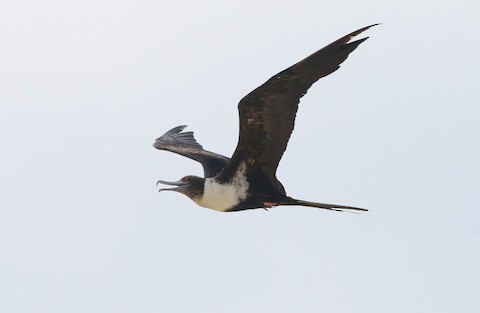
Lesser Frigatebird, subadult female. (Michaelmas Cay, Queensland, Australia; November 9, 2018.) © James Bailey
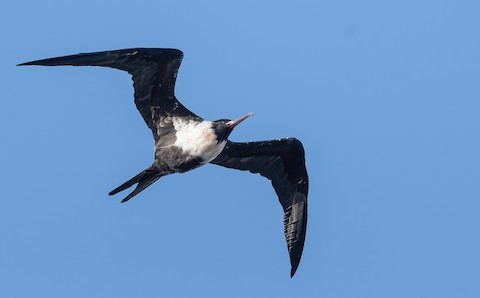
Lesser Frigatebird, subadult female. (Lady Elliot Island, Queensland, Australia; March 14, 2020.) © Barry Deacon
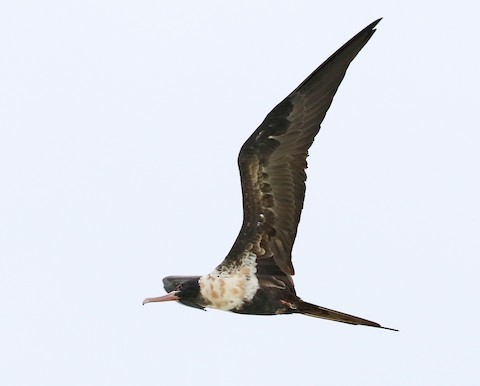
Lesser Frigatebird, subadult female. (Pulau Mantanani Besar, Sabah, Malaysia; November 5, 2018.) © Dave Bakewell

Lesser Frigatebird, subadult female. (Lady Elliot Island, Queensland, Australia; March 14, 2020.) © Barry Deacon
Subadult Male. Subadult males also go through various intermediate stages, initially resembling adult females—but without the white neck collar.
The belly becomes entirely black, so when seen from below they appear mostly blackish with a large white area on the chest and armpits.
Eventually the white chest area fills in with black feathers, resulting in essentially all-black plumage except for the characteristic white markings in the armpits.
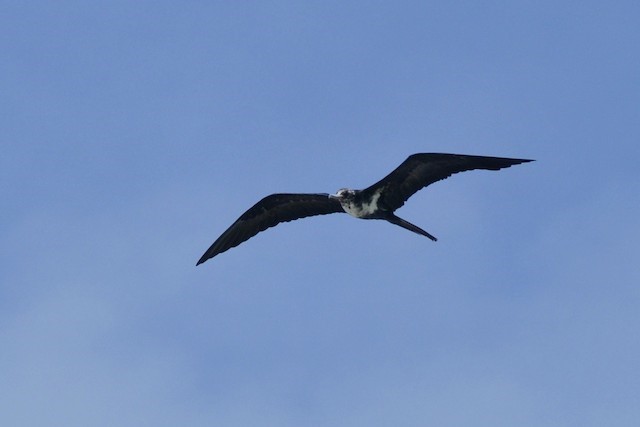
Lesser Frigatebird, subadult male, in molt-stage that resembles a female but lacks white collar. (Ngaontetaae Island, Kiribati; November 5, 2016.) © John Doty
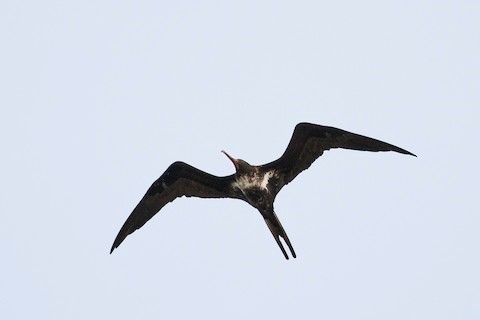
Lesser Frigatebird, subadult male. (Bird Island, Seychelles; December 1, 2019.) © RJ Dodd
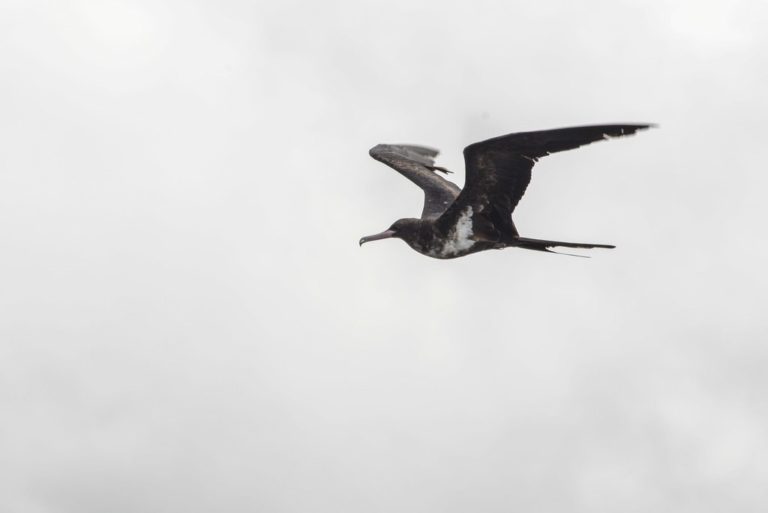
Lesser Frigatebird, subadult male. (Offshore from North Kalimantan, Indoenesia; April 21, 2018.) © binturong5

Lesser Frigatebird, subadult male. (Saumlaki, Yamdena Island, Maluku, Indonesia; October 2, 2017.) © Gil Ewing
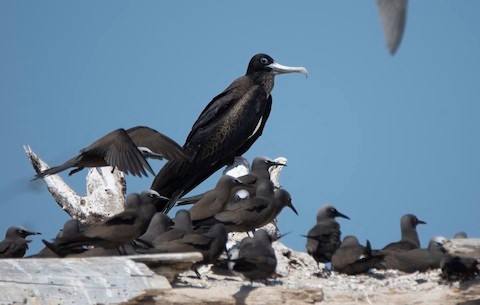
Lesser Frigatebird, subadult male. (Michaelmas Cay, Queensland, Australia; October 12, 2019.) © Nik Mulconray

Lesser Frigatebird, adult or subadult male with unusually extensive white armpit patches. (Jakarta Bay, Java, Indonesia; August 5, 2018.) © Matthew Kwan
Cf. Great Frigatebird. Great and Lesser Frigatebirds overlap widely from the South Atlantic east across the Indian Ocean and across most of the Pacific. Despite being nominal opposites, they differ only marginally in size. Adults of the two species are readily distinguishable, but the immature plumages are complex and confusing.
Adult Males: Distinctive. Male Great is essentially all-black, and male Lesser is readily recognized by its white armpit markings (usually conspicuous, but somewhat variable and can be subtle on some individuals).
Adult Females: Distinctive. Lesser has a full blackish hood, whereas Great has a pale throat.
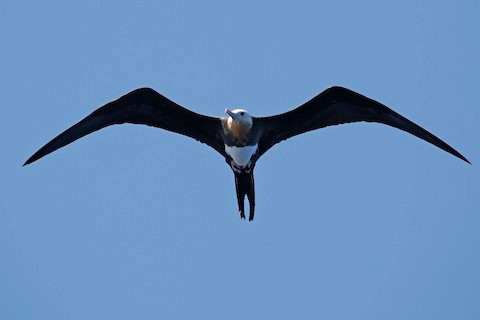
Great Frigatebird, juvenile, showing white underparts limited to body—all-dark armpits. (South of Ni’ihau, Hawaii; October 14, 2019.) © Laura Keene

Lesser Frigatebird, juvenile, showing white underparts extending to armpits. (Nanhui Dongtan, Shanghai, China; August 2, 2018.) © Yasuhiko Kumatsu
Immatures: Usually distinguishable, but complicated. Juveniles and older immatures can usually be identified through a clear view of the underparts. Most distinctively, on Lesser the white area on the breast and belly projects into the armpits, whereas Great rarely shows such projections. Lesser also tends to have a more extensively black chest, but this varies within each species individually and by age, and there is some overlap between them.

Great Frigatebird, subadult female showing slight white projections into armpits. (Kilauea Point National Wildlife Refuge, Kauai, Hawaii; October 17, 2018.) © Garrett Lau

Lesser Frigatebird, subadult male, in molt-stage that resembles a female Great Frigatebird. (Ngaontetaae Island, Kiribati; November 5, 2016.) © John Doty
Subadult Females: Usually distinguishable, but complicated. Female Lessers begin to darken on the throat, whereas female Greats do not, so this may allow for positive identification of Lesser in some cases. Most confusing about these plumages, subadult female Greats often show white projections into the armpits, so that characteristic of Lesser is less diagnostic in these plumages.
Subadult Males: Distinctive, but complicated. Subadult males of both species develop similarly, darkening first on the head and belly, developing a blackish hood and white vest, then becoming mottled throughout its underparts, but remaining whitest on the chest. The main difference is, as in adult males, Lesser’s white armpit markings.
Cf. Christmas Frigatebird. Christmas and Lesser Frigatebirds occur together throughout Indonesia, the Timor, Banda, and Arafura Seas, and in nearby portions of the Indian and western Pacific Oceans. Despite a significant difference in size, the potential to confuse them is high because both often show distinct white armpit projections, which are usually regarded as diagnostic for Lesser.
Adult Males: Distinctive in their definitive plumages. Male Christmas is black with a white belly and male Lesser is black with white markings in the armpits. The belly color is more diagnostic than the armpits, however, because subadult male Christmas often shows similar armpit markings.
Adult Females: Usually distinguishable, but complicated. Adult female Christmas and Lesser have essentially the same pattern of black and white, but with consistent deviations. The most obvious is the belly color: white on Christmas and black on Lesser. Apart from this and their sizes, the differences in pattern are small enough to escape notice under most field conditions.
Immatures: Often indistinguishable. Most confusing are the juvenile and other immature plumages, which can be essentially identical in color and pattern, with size being the only consistent difference until Lesser’s belly begins to darken.
Subadults: Usually distinguishable, but complicated. As the sexes differentiate, Christmas and Lesser Frigatebirds become easier to identify based on the color of the belly. Christmas’s belly is always white (at least mostly white), whereas subadult Lessers of both sexes darken on the belly while retaining a mostly white chest.
Cf. Magnificent Frigatebird. Magnificent and Lesser Frigatebirds occur together regularly to a very limited extent in Brazilian waters, and irregularly in the eastern Pacific—as Lesser has a history of long-distance vagrancy, including at least four records from North America and many from Hawaii. As the largest and smallest frigatebird species, their sizes may differ enough to be noticeable, but this is often difficult to judge.
Adult Males: Distinctive. Male Magnificent is essentially all-black, and male Lesser is readily recognized by its white armpit markings (usually conspicuous, but somewhat variable and can be subtle on some individuals).
Adult and Subadult Females: Sometimes indistinguishable by plumage alone (compare photos below). Both Magnificent and Lesser have a full blackish hood and white vest—and both can show pronounced white projections into the armpits, although this varies more on female Magnificent. Two features can be helpful.

Magnificent Frigatebird, female, showing white markings projecting into the armpits—similar to female Lesser Frigatebird. (Cancún, Quintana Roo, Mexico; February 17, 2015.) © Alexandre Gualhanone

Lesser Frigatebird, subadult female. (Lady Elliot Island, Queensland, Australia; March 14, 2020.) © Barry Deacon
First, adult female Lesser has a complete and usually well-defined white collar, whereas adult female Magnificent has a dark nape. Subadult female Magnificent can show a full white collar, but usually not as well-defined as on Lesser.
Second, the typical shapes of the white and black areas on the underparts differ (although both species vary): on Magnificent, the black belly projects toward the chest in a V, whereas on Lesser, this boundary is typically more U-shaped.
Immatures: Distinctive, but complex. Juveniles and most older immatures are distinguishable in multiple ways. Juvenile Lesser varies widely but seems to always have some buffy, tawny, orange, or rusty coloration on the head or neck, whereas juvenile Magnificent has all-white head and neck.
Older immatures of both species differ more in the pattern of the chest and sides: immature Lessers typically have a complete or partial black collar at chest level, whereas immature Magnificent can have a partial breastband, but it is lower on the body.
Subadult Males: Distinctive. The subadult male Magnificent is unique; it darkens in patches and becomes mottled throughout its underparts, usually remaining whitest on the belly. The subadult male Lesser darkens first on the head and belly, also becoming mottled throughout its underparts, but remaining whitest on the chest and armpits.
Subadult Males: Distinctive. The subadult male Magnificent is unique; it darkens in patches and becomes mottled throughout its underparts, usually remaining whitest on the belly. The subadult male Lesser darkens first on the head and belly, also becoming mottled throughout its underparts, but remaining whitest on the chest and armpits.
Notes
Polytypic species consisting of three recognized subspecies, one of which is a potentially distinct form that has been proposed for recognition as a separate species: “Trindade Frigatebird” (F. a. trinitatis).
The pertinent taxonomic authority, the South American Classification Committee, has initially rejected the proposed split due to the absence of definitive evidence that trinitatus differs substantially from the other subspecies (see Proposal 768 to South American Classification Committee: Elevate Fregata ariel trinitatis to species rank, https://www.museum.lsu.edu/~Remsen/SACCprop768.htm).
References
BirdLife International. 2018. Fregata ariel. The IUCN Red List of Threatened Species 2018: e.T22697738A132598822. https://dx.doi.org/10.2305/IUCN.UK.2018-2.RLTS.T22697738A132598822.en. (Accessed August 12, 2020.)
Brazil, M. 2009. Birds of East Asia. Princeton University Press.
eBird. 2020. eBird: An online database of bird distribution and abundance. Cornell Lab of Ornithology, Ithaca, N.Y. http://www.ebird.org. (Accessed August 12, 2020.)
Harrison, P. 1983. Seabirds: An Identification Guide. Houghton Mifflin, Boston.
Howell, S.N.G., I. Lewington, and W. Russell. 2014. Rare Birds of North America. Princeton University Press.
Howell, S.N.G., and K. Zufelt. 2019. Oceanic Birds of the World. Princeton University Press.
Olson, S.L. 2017. Species rank for the critically endangered Atlantic Lesser Frigatebird (Fregata trinitatis). Wilson Journal of Ornithology 129:661-675.
Port, D., J.O. Branco, C.E. de Alvarez, and F. Fisch. 2016. Observations on endangered frigatebirds (Fregata ariel trinitatis and F. minor nicolli, Suliformes: Fregatidae) at Trindade Island, Brazil. Pan-American Journal of Aquatic Sciences 11:87-92.
Pratt, H.D., P.L. Bruner, and D.G. Berrett. 1987. A Field Guide to the Birds of Hawaii and the Tropical Pacific. Princeton University Press.
Pyle, R.L., and P. Pyle. 2017. The Birds of the Hawaiian Islands: Occurrence, History, Distribution, and Status. Version 2 (January 1, 2017). http://hbs.bishopmuseum.org/birds/rlp-monograph/. B.P. Bishop Museum, Honolulu, Hawaii.
van Perlo, B. 2009. A Field Guide to the Birds of Brazil. Oxford University Press.
Wikiaves, Tesourão-pequeno, https://www.wikiaves.com.br/wiki/tesourao-pequeno.
